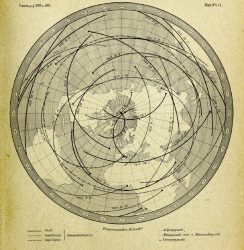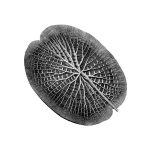FRANK MAKOWSKI – CANON DER FINSTERNISSE
Canon der Finsternisse translates as Canon of Eclipses. This album is based on(/inspired by) the late 19th-century publication by the Austrian Astronomer T.R. von Oppolzer, which listed up to 13000 (!) lunar and solar eclipses of past, present and future, as well as graphically documenting their course.
(If you’re interested or just want to take a quick peek: the Canon is freely available from Archive.org. It looks impressive, but it’s not exactly easy-late-night reading).
On his 10th official album (I’m embarrassed to admit that it’s the first one that came to my attention!), Frank Makowski “reflects the play of celestial mechanics, the vastness and void of space mankind is discovering and exploring with astronomy today.”
The (German) titles all refer to astronomical terms from this Canon:
Fliegende Schatten (Flying Shadows), for instance, is “a shape of casted shadows that occurs when only a small sickle of the sun is visible during an eclipse”.
Okkultation (Occultation) is the term for “the event when one object is hidden by another object that passes between it and the observer.”
Syzygy is “a straight-line configuration of three or more celestial bodies in a gravitational system.”
I’m not gonna mention them all – I guess you got the (celestial) picture by now.
What’s more important is that the instrumentation of these pieces is absolutely gripping from the beginning to the end. The fleeting choir in the opening track (as well as in the closing Sunnenvinster) is as seductive and bewitching as the Lorelei siren. The opening sighs of Kernschatten draws the listener literally into the deepest parts of shadows… I could write lines like this for every single track – however different in nature they are compared to each other. But I’ll stop here.
This is one of the – relatively rare – albums that immediately stopped me from whatever I was doing and made me sit down and listen. And listen again. And put it on repeat.
80 minutes of pure bliss – however eclipsed it may be!
MICROTUB – CHRONIC SHIFT 
Please don’t think twice, but I’m curious about your first reaction reading this description:
“Compositions for three microtonal tubas, recorded in binaural audio in a water reservoir, reworked and augmented with analog synthesizers”.
Mine was: “hmmm… a tuba trio… thát may sound interesting…”
I must confess it took a few minutes before I recognized the sound of a tuba at all: in the opening part of the 11-minute title track the reworked synth treatments are prominent. But as the piece evolves, the natural deep tuba sound comes forward, giving the piece its expected depth. Even more so in the second composition of this album, called System Reboot, which is twice as long (20 minutes).
The Microtub trio is Robin Hayward (microtonal F tuba), Martin Taxt and Peder Simonsen (both microtonal C tubas). I’m not exactly sure about how the microtonal tuba is different from an normal tuba, but it’s probably quite exceptional since this is “the world’s first and only microtonal tuba trio, exploring Just Intonation and the rich harmonic potential of the tuba.”
The binaural recording in the large water tank in Berlin-Pankow, with no less than 18 seconds of reverberation, adds to the aural environment. But it also merges with the sound of the tuba and with the extra addition of the analog synth in a way that it is not always clear what it exactly is you are listening to.
“The three tubas cease to sound like normal brass instruments and are turned into a machine transmitting harmonics as if from another world.”
But all this only adds to the adventure of this deep listening experience, where “the harmonics take on a sinusoid life of their own and live in an almost separate space above your head.”





